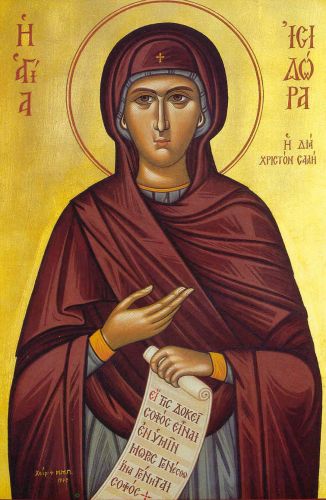|
|||
|---|---|---|---|
| This weekly bulletin insert complements the curriculum published by the Department of Christian Education of the Orthodox Church in America. This and many other Christian Education resources are available at http://dce.oca.org. | |||

The Holy Mother Isidora lived in the sixth century. Isidora spent most of her life in the monastery of Tabenna in Egypt. She chose to serve God in an extreme way, as a fool for Christ, living in complete self-denial and base servitude. By doing so, Isidora, like others who chose this way, made sure she would not be praised for her virtues, her constant prayer, or her service to God. When she ate thrown-away scraps and drank used dishwater, others treated her with contempt rather than honor. When she took on the most menial and unpleasant tasks she wasn't thanked; others considered that such an odd person might be expected to demean herself with those jobs. A monk named Pitirim was told about Isidora in a blunt way. An angel directed him to find her, comparing her to Pitirim himself: "She serves others and bears their contempt every day. Her heart and thoughts are always with God. You have the ease of solitude with nobody to disturb you, yet your thoughts and your heart are constantly distracted." Pitirim found Isidora, bowed before her, and revealed her holiness to the other nuns. But she fled from their praise, and they never saw her again. In the movie version of "Cinderella" directed by Kenneth Branagh, there are a few interesting parallels to this saint's life. The young heroine, Ella, loses the parents with whom she shared a deep love and a happy life. Her dying mother gives her a standard to live by: "Have courage and be kind." When her father remarries and then dies, Ella honors her mother's words, rather in the same way that saints live in a way that honors the commands of Christ. She cheerfully does the chores forced on her by a cruel stepmother and her daughters, who contemptuously call her Cinderella because she is constantly dirtied by ashes and soot. She doesn't seek revenge against their meanness, but takes comfort in the animals whose trusting companionship she wins, again like some well-known saints. The patience to endure unjust suffering in life takes courage, even if some critics of the movie have wrongly said that this Cinderella is weak because she doesn't stand up to her stepmother. But the movie is realistic about how hard it is to maintain this courage. At one point, when her harsh life has become unbearable, she rides away on a horse to escape. She meets a young huntsman named Kit, not knowing that he is actually the prince who will change her life. It's noteworthy that she first meets him not in a dazzling ballgown, as in the animated 1950's Disney version, but in her servant's clothes. He falls in love with a lowly servant, just as Christ loves us in our lowly sinfulness. Near the end of the movie, Cinderella confronts her stepmother, not to gloat in triumph at having won the prince's love, but to forgive this woman who has caused her such suffering. She knows that forgiveness is another act of courage and kindness—and of true strength. |
|||
